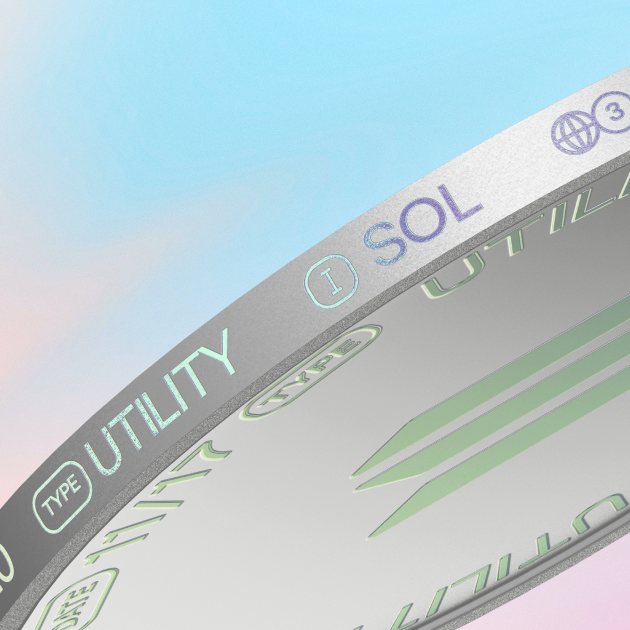What are utility tokens and how do they work?
Learn what makes utility tokens stand out from other cryptocurrencies, and how they function within different types of blockchain projects.
By Corey Barchat

In any blockchain ecosystem, there are certain types of tokens that perform a necessary role. Oftentimes, these specialty tokens offer unique functionalities that go beyond traditional cryptocurrencies.
For example, there are governance tokens that allow the holder to vote on protocols, and security tokens that represent ownership in real-world assets. There are also utility tokens.
Utility tokens occupy a unique niche within the blockchain ecosystem, playing a crucial role in the functionality and growth of decentralized applications (dApps) and other DeFi protocols.
But what exactly are utility tokens and how do they function?
In this guide, we'll examine what utility tokens are, how they work, and take a look at some real world examples.
What is a utility token?
Utility tokens are a type of cryptocurrency designed to provide access to a specific function or service within a blockchain ecosystem. Unlike traditional cryptocurrencies such as Bitcoin, which primarily serve as a medium of exchange, utility tokens are integral to the functioning of DeFi applications.
They are also distinct from security tokens, which represent ownership in a company or asset. Utility tokens are not intended to be investments, but rather grant holders access to particular features or perks on the issuing platform.
Some of the earliest examples of utility tokens include ERC-20 tokens that run on the Ethereum network, which users must hold to execute smart contracts and engage in decentralized finance (DeFi). Other early examples include Filecoin (FIL) and Golem (GLM), which provide decentralized storage and computing power, respectively.
Since their inception, utility tokens have evolved significantly. While they were initially seen as simple access keys, they have grown to incorporate more complex functionalities. This includes things like incentivizing user behavior, enabling decentralized governance, and driving ecosystem growth.
Some key milestones in the evolution of utility tokens include:
- 2015: Launch of Ethereum, introducing smart contracts and utility tokens.
- 2017: ERC-20 proposed in EIP-20, coinciding with the ICO boom that saw numerous projects issuing utility tokens.
- 2020: Rise of DeFi (decentralized finance), incorporating utility tokens for innovative financial protocols.
- 2021: Increased adoption of utility tokens in various industries, including gaming, finance, and supply chain.
How do utility tokens work?
Utility tokens function as access keys within a blockchain ecosystem. They are often required to utilize a service, participate in a network, or execute a transaction. But how are they created and deployed?
Utility token creation
Utility tokens are typically created through a process called tokenization. This involves the following steps:
- Platform selection: The project team selects a blockchain platform that supports the creation of tokens like Ethereum (ERC-20), Binance Smart Chain (BEP-20), and Solana (SPL).
- Smart contract development: The development team writes a smart contract, which is a self-executing program with the terms of the token issuance encoded within it.
- Token standard compliance: The smart contract adheres to the chosen platform’s token standard to ensure compatibility and interoperability. For instance, an ERC-20 token on Ethereum must comply with the ERC-20 standard, which specifies functions like totalSupply, balanceOf, transfer, and approve.
- Token minting: Once the smart contract is deployed on the blockchain, the tokens are “minted,” or created, according to the parameters set in the contract.
This process culminates with the generation of the initial token supply and allocation to specific wallet addresses, such as the project’s wallet, early adopters, and a reserve for future use. Some mechanisms for distribution include Initial Coin Offerings (ICOs), Initial Exchange Offerings (IEOs), airdrops, and token swaps.
After their creation and distribution, utility tokens can be bought, sold, and traded on cryptocurrency exchanges.
Applications within blockchain networks
Utility tokens have a wide range of roles and functions in their respective blockchain network:
1) Access to services
One of the primary functions of utility tokens is to grant access to services provided by a blockchain platform. For example, Filecoin uses its tokens to allow users to purchase storage space on its decentralized network. Similarly, the Basic Attention Token (BAT) is used within the Brave browser to reward users for viewing advertisements and interacting with the platform.
2) Facilitating transactions
Utility tokens often serve as a medium for transactions within a specific ecosystem. They can be used to pay for transaction fees, services, transfer value, or participate in platform activities. For instance, Golem tokens (GLM) are used to pay for computing power on the Golem network, allowing users to rent processing power for various tasks.
3) Incentivizing participation
Many blockchain platforms use utility tokens to incentivize user participation and engagement. Tokens can be rewarded for contributing to the network, such as validating transactions, providing liquidity, creating content, or providing services. For example, Socios is a sports platform that rewards fans with Chiliz (CHZ) tokens that can be used to interact with their favorite clubs and players, and redeemed for real-world prizes.
Interaction with decentralized applications (dApps)
Utility tokens are integral to the operation of dApps (decentralized applications) in areas like the metaverse, NFTs, and real world sustainability. They facilitate interactions between users and the application, enabling functionalities such as voting, staking, and accessing premium content. This interaction often involves smart contracts, which automate processes and ensure transparency and security.
Key differences between utility tokens and other tokens
The cryptocurrency landscape is diverse, encompassing various types of digital assets. Broadly, these can be categorized into:
- Cryptocurrencies: Digital currencies designed to function as a medium of exchange.
- Utility tokens: Tokens that provide access to a product or service within a blockchain ecosystem.
- Security tokens: Tokens that represent ownership or a stake in an external asset or enterprise; often considered securities and subject to securities regulations.
- Governance tokens: Tokens that provide holders with voting rights on the development and operation of a blockchain project or decentralized autonomous organization (DAO).
We can use a table to further illustrate the differences between token types:
Feature | Utility Tokens | Security Tokens | Cryptocurrencies | Governance Tokens |
Primary Purpose | Access to services or functions within a platform | Represent ownership or investment in an asset | Medium of exchange | Participate in platform governance |
Regulatory Classification | Generally not classified as securities | May be classified as securities by regulators | May be subject to various regulations | Generally not classified as securities |
Use Case Examples | BAT, LINK, MANA, VET | Polymath, INX, Securitize | Bitcoin, Litecoin | Uniswap (UNI), Compound (COMP), Maker (MKR) |
Benefits of utility tokens
Utility tokens offer a wide array of advantages that contribute to the growth and functionality of blockchain networks and decentralized applications:
Advantages for users and developers
Utility tokens can be beneficial to multiple participants in a cryptocurrency ecosystem:
- For users: Utility tokens enable users to access services, pay for transactions, and participate in platform activities. They can earn more tokens through their participation, creating a more engaging and rewarding experience.
- For developers: Utility tokens offer a means to fund their projects and incentivize user engagement. By issuing utility tokens, developers can raise capital through token sales, which can be used to build and improve their platforms.
Efficient transactions
Utility tokens are often used to pay for transaction fees within their respective networks, ensuring that transactions are processed efficiently. For instance, Ether (ETH) is used to pay for gas fees on the Ethereum network, which facilitates the execution of smart contracts and dApp interactions.
Incentivizing interactions
By providing incentives for users to participate in network activities, utility tokens help maintain and secure the network. For example, in Proof-of-Stake (PoS) networks like Cardano and Solana, ADA and SOL tokens are staked by validators to secure their respective networks and process transactions, earning staking rewards in return.
Access to services
Utility tokens grant holders access to specific services and features within a platform. For instance, Enjin Coin (ENJ) allows gamers to create, manage, and trade in-game assets, enhancing the gaming experience and providing real-world value to virtual items.
Powering DeFi
Utility tokens are at the heart of the DeFi movement, enabling a wide range of financial services that don't rely on third parties or intermediaries. Tokens like Compound (COMP) and Aave (AAVE) are used in lending and borrowing protocols, providing users with decentralized access to financial services.
Democratizing participation
Many utility tokens enable decentralized governance, allowing utility token holders to participate in decision-making processes. This democratizes platform management and ensures that the community has a say in the platform's development. Uniswap's UNI tokens, for example, allow holders to vote on upgrades and changes to the DEX protocol.
Examples of notable utility tokens
While many cryptocurrencies perform a specific function, that does not mean all coins are necessarily utility tokens. Here are some of the most commonly used utility tokens that provide specific services for users.
BAT (Basic Attention Token)

Basic Attention Token (BAT) is designed to revolutionize digital advertising by improving the efficiency and transparency of online ads. BAT is used within the Brave browser ecosystem, where users earn tokens by opting into privacy-respecting ads and can use them to support content creators and access premium features.
LINK (Chainlink)

Chainlink (LINK) is a decentralized oracle network that enables smart contracts to securely interact with real-world data and external APIs. LINK tokens are used to pay for data services provided by Chainlink's oracles and to incentivize data providers and operators to maintain accurate and reliable data feeds.
BNB (Binance Coin)

Binance Coin (BNB) is the native utility token of the Binance ecosystem, which includes the Binance Exchange and Binance Smart Chain. BNB is used to pay for transaction fees on Binance at a discounted rate, participate in token launches on Binance Launchpad, and interact with various DeFi applications on Binance Smart Chain.
ENJ (Enjin Coin)

Enjin Coin (ENJ) is a utility token designed for gaming on Enjin, the blockchain-based platform that allows users to create, manage, and trade virtual goods and in-game items. Every in-game item minted with Enjin's tools contains ENJ tokens, ensuring that the items have real-world value and liquidity.
MANA (Decentraland)

Decentraland (MANA) powers the immersive Decentraland virtual world platform. The MANA utility token can be used to purchase virtual land, goods, and services within the Decentraland metaverse, and also allows holders to participate in various virtual experiences and events.
VET (VeChain)

VeChain (VET) is the utility token of the VeChainThor blockchain, which focuses on supply chain management and enterprise solutions. VET tokens are used to pay for transaction fees and interact with VeChain blockchain services. They play a crucial role in VeChain's goal to enhance supply chain transparency, by enabling businesses to track and verify products throughout their lifecycle.
Challenges & limitations of utility tokens
While utility tokens offer numerous benefits, they also face several challenges and limitations that can impact their effectiveness and adoption.
Regulatory ambiguity
The regulatory status of utility tokens can vary significantly across different jurisdictions. In some countries, the lack of clear guidelines creates uncertainty for projects, with regulatory bodies still grappling with how to classify and regulate utility tokens.
Potential reclassification
There is a risk that utility tokens could be classified as securities by regulatory authorities if they are deemed to have investment characteristics. This classification could subject them to stricter regulations and legal requirements, potentially impacting their use and value.
User experience
The complexity of blockchain technology can be a barrier to adoption. Users often need to navigate complicated processes to acquire, store, and use utility tokens. Improving the user experience and making blockchain technology more accessible is essential for unlocking broader adoption.
Integration with traditional systems
Integrating utility tokens with existing traditional systems and infrastructure can present another adoption barrier. Businesses and consumers may be reluctant to adopt new technologies that require significant changes to their current operations.
Smart contract vulnerabilities
The smart contracts used in many dApps present some security risks, as they can contain bugs or vulnerabilities that malicious actors can exploit. Regular audits, peer reviews, and formal verification methods are essential to help prevent loss of funds and maintain user trust.
Hacking and theft
Utility tokens have been targeted by hackers in the past. High-profile exchanges and wallets have been hacked, resulting in the theft of millions of dollars' worth of tokens. Implementing robust security measures to protect tokens and user assets is vital for any platform. This includes multi-layered security approaches, such as "cold storage" for funds, two-factor authentication, and regular security audits.
Utility token FAQs
Are utility tokens regulated?
The regulatory scrutiny and legal status of utility tokens vary by jurisdiction. In some countries, they may fall under the purview of financial regulators if they exhibit characteristics similar to securities. It's important for projects to ensure compliance with local laws to avoid legal issues, while users should check their local laws and regulations.
How can I buy utility tokens?
MoonPay offers an easy and fast way to buy and sell utility tokens using fiat currency.
To get started, just top up your wallet in euros, pounds, or dollars and use your MoonPay Balance to purchase utility tokens like Ethereum (ETH). Then, simply transact for cheaper and faster transactions with higher approval rates. Plus, enjoy zero-fee withdrawals directly to your bank account when you decide to cash out.
Where can I store utility tokens?
Utility tokens can be stored in various types of cryptocurrency wallets, including software wallets (desktop or mobile apps), and hardware wallets (physical devices). When choosing a wallet, users should check to make sure that it supports the specific utility token standard. For example, an Ethereum wallet that supports the ERC-20 standard for Ethereum-based utility tokens.
How can I use utility tokens?
Utility tokens can be used within their respective platforms to access services, pay for transactions, or unlock premium features. For example, users might use tokens to access decentralized applications (dApps), pay transaction (gas) fees, or receive rewards for contributing to the ecosystem. Each token’s use case depends on the specific functions and features of the blockchain platform it supports.
Are utility tokens different from security tokens?
Utility tokens are not the same as security tokens. While utility tokens provide access to distinct features in a blockchain protocol, security tokens represent ownership or a stake in an external asset and are subject to securities regulations.
Can the value of utility tokens increase?
The value of utility tokens can increase based on factors such as the demand for the underlying service or product, the success and adoption of the platform, and overall market conditions. However, like all cryptocurrencies, their value can also be highly volatile and speculative. Users should always perform their own research before investing in any cryptocurrency asset like utility tokens.
Getting started with utility tokens
Utility tokens allow users to access engaging platforms that are built on blockchain technology. But before you can use them for decentralized finance (DeFi), gaming, and more, you'll need to possess the required cryptocurrency.
MoonPay makes it easy to buy utility tokens like Ether (ETH), Binance Coin (BNB), Chainlink (LINK), Basic Attention Token (BAT), Cardano (ADA), and Uniswap (UNI). Just enter the amount of crypto you wish to purchase, and choose from many preferred payment methods like card, bank transfer, Apple Pay, and more.






